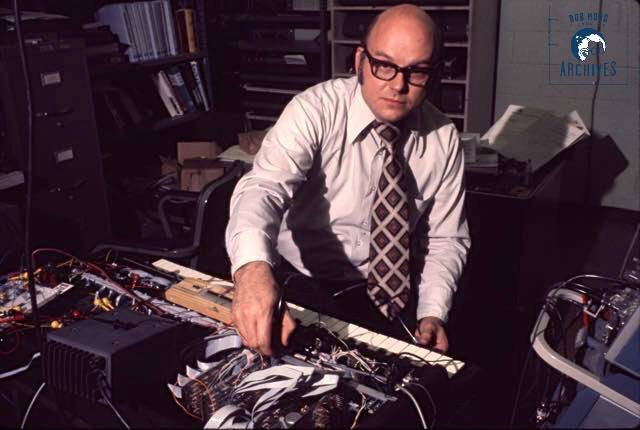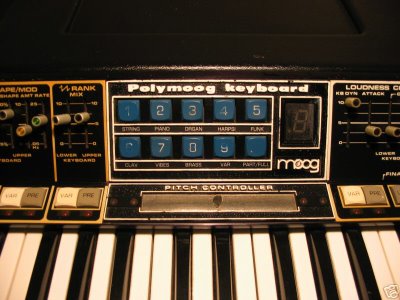News is in that Dave Luce passed away yesterday, April 15, at the age of 80. That's him working on the Polymoog back in the day. I spotted the image and news in
this tweet by @casadistortion.
"RIP David Luce, designer of the groundbreaking Polymoog."
You can find a
video interview with Dave Luce in NAMM's Oral Histories site here.
See here for a polymoog promotional film featuring David Luce.
via
The Buffalo News:
"After a brief stint at Sperry Rand, where he worked on high-speed digital circuitry, Mr. Luce joined Moog Music in 1972 and invented the first commercial polyphonic synthesizer, the Polymoog.
He became head of engineering, was promoted to president of Moog in 1981, and became a co-owner in 1984. He oversaw and contributed directly to the development of Moog synthesizers and other products.
In developing those instruments, he worked with Keith Emerson of Emerson Lake & Palmer and many other artists on whose music his innovations had a significant impact.
After Moog closed in 1987, Mr. Luce embarked on a new career, helping to develop and refine ophthalmic diagnostic instruments at Reichert Technologies. In 2000 he made an important discovery relating to properties of the cornea, and in 2005 he published a now widely cited paper that earned him recognition as the 'Father of Corneal Biomechanics.'"
And via
Marc Doty, aka
Automatic Gainsay:
"Dave Luce has passed away.
Bill Waytena, the guy who bought R.A. Moog and turned it into Moog Music in the early part of the 70s, hired Dave to create a polyphonic synthesizer. The synthesizer he created was the Polymoog.
The Polymoog was a complicated design that tried to cope with the issues involved in creating an articulated polyphonic design. Polyphonic electronic keyboards had been created for years, going back to 1937, when Harald Bode created the Warbo Formant Organ. But the problem with applying Bob Moog's synthesis concept to polyphony was that the user was probably going to want each voice to be fully articulated... and that was complex and expensive.
Dave's design essentially addressed the challenge by creating an IC chip for each key that gave each key a synthesizer.
The Polymoog was riddled with challenges and failings, but overall, it was a huge success... being the first, and most effective, application of voltage control to polyphony.
Of course, it couldn't have a ladder filter per key, which meant that the Polymoog had great presets, but fell short when it came to polyphonic synthesis.
Bob described Dave as pursuing overly-complicated designs. Anyone who has ever owned or repaired a Polymoog, should probably agree.
But still... the Polymoog got us started in the modern age, and it was a popular and useful design. Dave Luce worked hard for Moog Music, and is responsible for a lot in regard to that which was created by that company in the 1970s.
Thank you, Dave, for all of your great work.
http://buffalonews.com/…/david-alan-luce-moog-president-pi…/
P.S. We should also thank Keith Emerson... because his input on the Apollo design led to the improved Polymoog."
You can
check out the Moog Apollo in the Bob Moog Foundation Archives videos posted here.
Update via Ben Luce in the comments:
"This is Ben Luce, Dave Luce's son. I appreciate the commentary above very much.
Thank you for posting it. I would like to comment though that I have never agreed
with Bob Moog's characterization of my father as pursuing overly-complicated designs.
As your good commentary above notes, my Dad was struggling with very complicated design issues
with the polymoog, and was doing so in era where integrated circuits and instruments of the complexity
of the polymoog were quite new and unexplored.
But perhaps more to the point, to my understanding the primary failing of the poly was that the individual
circuit cards for each key were not soldered down: They were intentionally left removable because
there was some well grounded concern that voltage spikes from bad power on the grid
could cause the special chips that each carried to fail occasionally, necessitating
occasional replacements. As it turned out, these chips almost never failed, which I think is a testament to
the careful design of the chips in terms of component tolerances and such, and of the circuitry
that supported them. So in fact, the failure was really an engineering problem, not
a failure of my Dad's design work per se. Moreover, my Dad worked on all sorts of synthesizers for
Moog Music after that, and created some before that, and in no way were these generally plagued by some
tendency towards over complicated design. The same holds for his subsequent work on
ophthalmic instruments, which led to him finally to be recognized widely as "The Father
of Corneal Biomechanics".
In truth, my father actually loved and sought simplicity in
his work wherever it could be found. He was a true physicist, and physicists are steeped in the
virtues of simplicity and symmetry and mathematical beauty from the get-go.
Finally, it should be mentioned in this context that Bog Moog only worked directly with my
father for a few years, and I don't believe he worked very directly with him on
detailed circuit design issues, except perhaps when my Dad was first involved with improving
some of Bob's older designs. Bog also made those comments long after having left the company for
reasons that had little to do with my father, and that these may reflect some overall bitterness
about that not related to my Dad. For my Dad's part, I never heard him say an ill word about Bog.
He greatly admired Bob's work, and was proud to worked for him and for Moog Music in general."
Update: see
this post for a recent restoration of David Alan Laces Polymoog.




































































